Yang Shi
MorphoBench: A Benchmark with Difficulty Adaptive to Model Reasoning
Oct 16, 2025Abstract:With the advancement of powerful large-scale reasoning models, effectively evaluating the reasoning capabilities of these models has become increasingly important. However, existing benchmarks designed to assess the reasoning abilities of large models tend to be limited in scope and lack the flexibility to adapt their difficulty according to the evolving reasoning capacities of the models. To address this, we propose MorphoBench, a benchmark that incorporates multidisciplinary questions to evaluate the reasoning capabilities of large models and can adjust and update question difficulty based on the reasoning abilities of advanced models. Specifically, we curate the benchmark by selecting and collecting complex reasoning questions from existing benchmarks and sources such as Olympiad-level competitions. Additionally, MorphoBench adaptively modifies the analytical challenge of questions by leveraging key statements generated during the model's reasoning process. Furthermore, it includes questions generated using simulation software, enabling dynamic adjustment of benchmark difficulty with minimal resource consumption. We have gathered over 1,300 test questions and iteratively adjusted the difficulty of MorphoBench based on the reasoning capabilities of models such as o3 and GPT-5. MorphoBench enhances the comprehensiveness and validity of model reasoning evaluation, providing reliable guidance for improving both the reasoning abilities and scientific robustness of large models. The code has been released in https://github.com/OpenDCAI/MorphoBench.
BaseReward: A Strong Baseline for Multimodal Reward Model
Sep 19, 2025Abstract:The rapid advancement of Multimodal Large Language Models (MLLMs) has made aligning them with human preferences a critical challenge. Reward Models (RMs) are a core technology for achieving this goal, but a systematic guide for building state-of-the-art Multimodal Reward Models (MRMs) is currently lacking in both academia and industry. Through exhaustive experimental analysis, this paper aims to provide a clear ``recipe'' for constructing high-performance MRMs. We systematically investigate every crucial component in the MRM development pipeline, including \textit{reward modeling paradigms} (e.g., Naive-RM, Critic-based RM, and Generative RM), \textit{reward head architecture}, \textit{training strategies}, \textit{data curation} (covering over ten multimodal and text-only preference datasets), \textit{backbone model} and \textit{model scale}, and \textit{ensemble methods}. Based on these experimental insights, we introduce \textbf{BaseReward}, a powerful and efficient baseline for multimodal reward modeling. BaseReward adopts a simple yet effective architecture, built upon a {Qwen2.5-VL} backbone, featuring an optimized two-layer reward head, and is trained on a carefully curated mixture of high-quality multimodal and text-only preference data. Our results show that BaseReward establishes a new SOTA on major benchmarks such as MM-RLHF-Reward Bench, VL-Reward Bench, and Multimodal Reward Bench, outperforming previous models. Furthermore, to validate its practical utility beyond static benchmarks, we integrate BaseReward into a real-world reinforcement learning pipeline, successfully enhancing an MLLM's performance across various perception, reasoning, and conversational tasks. This work not only delivers a top-tier MRM but, more importantly, provides the community with a clear, empirically-backed guide for developing robust reward models for the next generation of MLLMs.
Collaborative-Online-Learning-Enabled Distributionally Robust Motion Control for Multi-Robot Systems
Aug 24, 2025Abstract:This paper develops a novel COllaborative-Online-Learning (COOL)-enabled motion control framework for multi-robot systems to avoid collision amid randomly moving obstacles whose motion distributions are partially observable through decentralized data streams. To address the notable challenge of data acquisition due to occlusion, a COOL approach based on the Dirichlet process mixture model is proposed to efficiently extract motion distribution information by exchanging among robots selected learning structures. By leveraging the fine-grained local-moment information learned through COOL, a data-stream-driven ambiguity set for obstacle motion is constructed. We then introduce a novel ambiguity set propagation method, which theoretically admits the derivation of the ambiguity sets for obstacle positions over the entire prediction horizon by utilizing obstacle current positions and the ambiguity set for obstacle motion. Additionally, we develop a compression scheme with its safety guarantee to automatically adjust the complexity and granularity of the ambiguity set by aggregating basic ambiguity sets that are close in a measure space, thereby striking an attractive trade-off between control performance and computation time. Then the probabilistic collision-free trajectories are generated through distributionally robust optimization problems. The distributionally robust obstacle avoidance constraints based on the compressed ambiguity set are equivalently reformulated by deriving separating hyperplanes through tractable semi-definite programming. Finally, we establish the probabilistic collision avoidance guarantee and the long-term tracking performance guarantee for the proposed framework. The numerical simulations are used to demonstrate the efficacy and superiority of the proposed approach compared with state-of-the-art methods.
VersaVid-R1: A Versatile Video Understanding and Reasoning Model from Question Answering to Captioning Tasks
Jun 10, 2025Abstract:Recent advancements in multimodal large language models have successfully extended the Reason-Then-Respond paradigm to image-based reasoning, yet video-based reasoning remains an underdeveloped frontier, primarily due to the scarcity of high-quality reasoning-oriented data and effective training methodologies. To bridge this gap, we introduce DarkEventInfer and MixVidQA, two novel datasets specifically designed to stimulate the model's advanced video understanding and reasoning abilities. DarkEventinfer presents videos with masked event segments, requiring models to infer the obscured content based on contextual video cues. MixVidQA, on the other hand, presents interleaved video sequences composed of two distinct clips, challenging models to isolate and reason about one while disregarding the other. Leveraging these carefully curated training samples together with reinforcement learning guided by diverse reward functions, we develop VersaVid-R1, the first versatile video understanding and reasoning model under the Reason-Then-Respond paradigm capable of handling multiple-choice and open-ended question answering, as well as video captioning tasks. Extensive experiments demonstrate that VersaVid-R1 significantly outperforms existing models across a broad spectrum of benchmarks, covering video general understanding, cognitive reasoning, and captioning tasks.
MME-VideoOCR: Evaluating OCR-Based Capabilities of Multimodal LLMs in Video Scenarios
May 27, 2025Abstract:Multimodal Large Language Models (MLLMs) have achieved considerable accuracy in Optical Character Recognition (OCR) from static images. However, their efficacy in video OCR is significantly diminished due to factors such as motion blur, temporal variations, and visual effects inherent in video content. To provide clearer guidance for training practical MLLMs, we introduce the MME-VideoOCR benchmark, which encompasses a comprehensive range of video OCR application scenarios. MME-VideoOCR features 10 task categories comprising 25 individual tasks and spans 44 diverse scenarios. These tasks extend beyond text recognition to incorporate deeper comprehension and reasoning of textual content within videos. The benchmark consists of 1,464 videos with varying resolutions, aspect ratios, and durations, along with 2,000 meticulously curated, manually annotated question-answer pairs. We evaluate 18 state-of-the-art MLLMs on MME-VideoOCR, revealing that even the best-performing model (Gemini-2.5 Pro) achieves an accuracy of only 73.7%. Fine-grained analysis indicates that while existing MLLMs demonstrate strong performance on tasks where relevant texts are contained within a single or few frames, they exhibit limited capability in effectively handling tasks that demand holistic video comprehension. These limitations are especially evident in scenarios that require spatio-temporal reasoning, cross-frame information integration, or resistance to language prior bias. Our findings also highlight the importance of high-resolution visual input and sufficient temporal coverage for reliable OCR in dynamic video scenarios.
Mavors: Multi-granularity Video Representation for Multimodal Large Language Model
Apr 14, 2025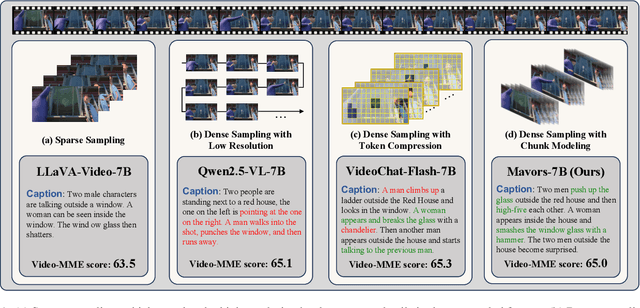

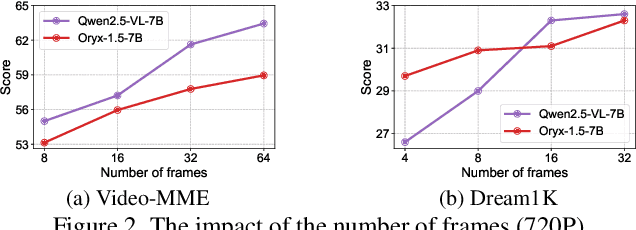
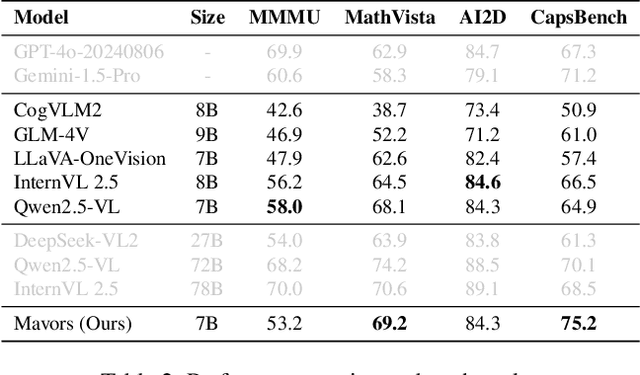
Abstract:Long-context video understanding in multimodal large language models (MLLMs) faces a critical challenge: balancing computational efficiency with the retention of fine-grained spatio-temporal patterns. Existing approaches (e.g., sparse sampling, dense sampling with low resolution, and token compression) suffer from significant information loss in temporal dynamics, spatial details, or subtle interactions, particularly in videos with complex motion or varying resolutions. To address this, we propose $\mathbf{Mavors}$, a novel framework that introduces $\mathbf{M}$ulti-gr$\mathbf{a}$nularity $\mathbf{v}$ide$\mathbf{o}$ $\mathbf{r}$epre$\mathbf{s}$entation for holistic long-video modeling. Specifically, Mavors directly encodes raw video content into latent representations through two core components: 1) an Intra-chunk Vision Encoder (IVE) that preserves high-resolution spatial features via 3D convolutions and Vision Transformers, and 2) an Inter-chunk Feature Aggregator (IFA) that establishes temporal coherence across chunks using transformer-based dependency modeling with chunk-level rotary position encodings. Moreover, the framework unifies image and video understanding by treating images as single-frame videos via sub-image decomposition. Experiments across diverse benchmarks demonstrate Mavors' superiority in maintaining both spatial fidelity and temporal continuity, significantly outperforming existing methods in tasks requiring fine-grained spatio-temporal reasoning.
MME-Unify: A Comprehensive Benchmark for Unified Multimodal Understanding and Generation Models
Apr 07, 2025Abstract:Existing MLLM benchmarks face significant challenges in evaluating Unified MLLMs (U-MLLMs) due to: 1) lack of standardized benchmarks for traditional tasks, leading to inconsistent comparisons; 2) absence of benchmarks for mixed-modality generation, which fails to assess multimodal reasoning capabilities. We present a comprehensive evaluation framework designed to systematically assess U-MLLMs. Our benchmark includes: Standardized Traditional Task Evaluation. We sample from 12 datasets, covering 10 tasks with 30 subtasks, ensuring consistent and fair comparisons across studies." 2. Unified Task Assessment. We introduce five novel tasks testing multimodal reasoning, including image editing, commonsense QA with image generation, and geometric reasoning. 3. Comprehensive Model Benchmarking. We evaluate 12 leading U-MLLMs, such as Janus-Pro, EMU3, VILA-U, and Gemini2-flash, alongside specialized understanding (e.g., Claude-3.5-Sonnet) and generation models (e.g., DALL-E-3). Our findings reveal substantial performance gaps in existing U-MLLMs, highlighting the need for more robust models capable of handling mixed-modality tasks effectively. The code and evaluation data can be found in https://mme-unify.github.io/.
Scalable Overload-Aware Graph-Based Index Construction for 10-Billion-Scale Vector Similarity Search
Feb 28, 2025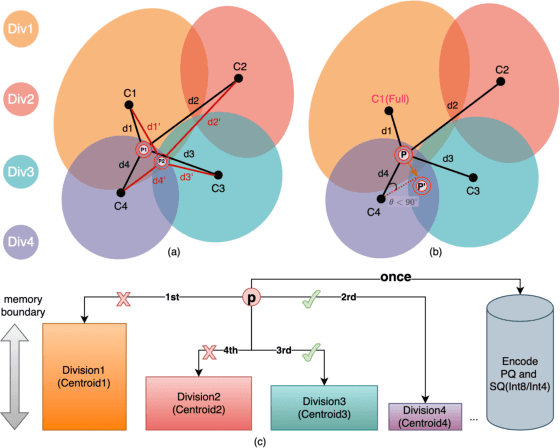
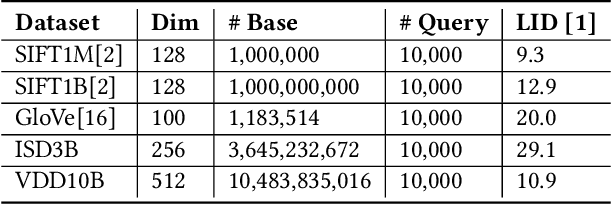
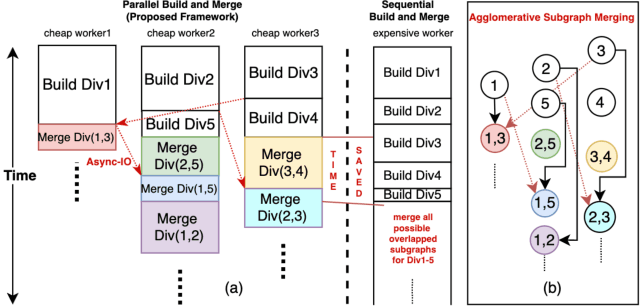
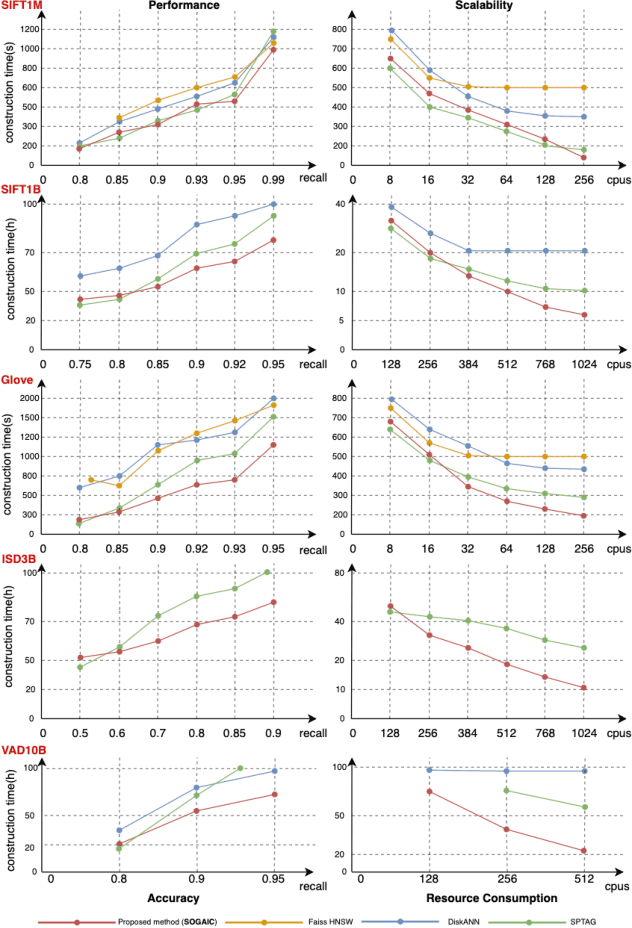
Abstract:Approximate Nearest Neighbor Search (ANNS) is essential for modern data-driven applications that require efficient retrieval of top-k results from massive vector databases. Although existing graph-based ANNS algorithms achieve a high recall rate on billion-scale datasets, their slow construction speed and limited scalability hinder their applicability to large-scale industrial scenarios. In this paper, we introduce SOGAIC, the first Scalable Overload-Aware Graph-Based ANNS Index Construction system tailored for ultra-large-scale vector databases: 1) We propose a dynamic data partitioning algorithm with overload constraints that adaptively introduces overlaps among subsets; 2) To enable efficient distributed subgraph construction, we employ a load-balancing task scheduling framework combined with an agglomerative merging strategy; 3) Extensive experiments on various datasets demonstrate a reduction of 47.3% in average construction time compared to existing methods. The proposed method has also been successfully deployed in a real-world industrial search engine, managing over 10 billion daily updated vectors and serving hundreds of millions of users.
AI Models Still Lag Behind Traditional Numerical Models in Predicting Sudden-Turning Typhoons
Feb 22, 2025Abstract:Given the interpretability, accuracy, and stability of numerical weather prediction (NWP) models, current operational weather forecasting relies heavily on the NWP approach. In the past two years, the rapid development of Artificial Intelligence (AI) has provided an alternative solution for medium-range (1-10 days) weather forecasting. Bi et al. (2023) (hereafter Bi23) introduced the first AI-based weather prediction (AIWP) model in China, named Pangu-Weather, which offers fast prediction without compromising accuracy. In their work, Bi23 made notable claims regarding its effectiveness in extreme weather predictions. However, this claim lacks persuasiveness because the extreme nature of the two tropical cyclones (TCs) examples presented in Bi23, namely Typhoon Kong-rey and Typhoon Yutu, stems primarily from their intensities rather than their moving paths. Their claim may mislead into another meaning which is that Pangu-Weather works well in predicting unusual typhoon paths, which was not explicitly analyzed. Here, we reassess Pangu-Weather's ability to predict extreme TC trajectories from 2020-2024. Results reveal that while Pangu-Weather overall outperforms NWP models in predicting tropical cyclone (TC) tracks, it falls short in accurately predicting the rarely observed sudden-turning tracks, such as Typhoon Khanun in 2023. We argue that current AIWP models still lag behind traditional NWP models in predicting such rare extreme events in medium-range forecasts.
EmbodiedEval: Evaluate Multimodal LLMs as Embodied Agents
Jan 21, 2025



Abstract:Multimodal Large Language Models (MLLMs) have shown significant advancements, providing a promising future for embodied agents. Existing benchmarks for evaluating MLLMs primarily utilize static images or videos, limiting assessments to non-interactive scenarios. Meanwhile, existing embodied AI benchmarks are task-specific and not diverse enough, which do not adequately evaluate the embodied capabilities of MLLMs. To address this, we propose EmbodiedEval, a comprehensive and interactive evaluation benchmark for MLLMs with embodied tasks. EmbodiedEval features 328 distinct tasks within 125 varied 3D scenes, each of which is rigorously selected and annotated. It covers a broad spectrum of existing embodied AI tasks with significantly enhanced diversity, all within a unified simulation and evaluation framework tailored for MLLMs. The tasks are organized into five categories: navigation, object interaction, social interaction, attribute question answering, and spatial question answering to assess different capabilities of the agents. We evaluated the state-of-the-art MLLMs on EmbodiedEval and found that they have a significant shortfall compared to human level on embodied tasks. Our analysis demonstrates the limitations of existing MLLMs in embodied capabilities, providing insights for their future development. We open-source all evaluation data and simulation framework at https://github.com/thunlp/EmbodiedEval.
 Add to Chrome
Add to Chrome Add to Firefox
Add to Firefox Add to Edge
Add to Edge